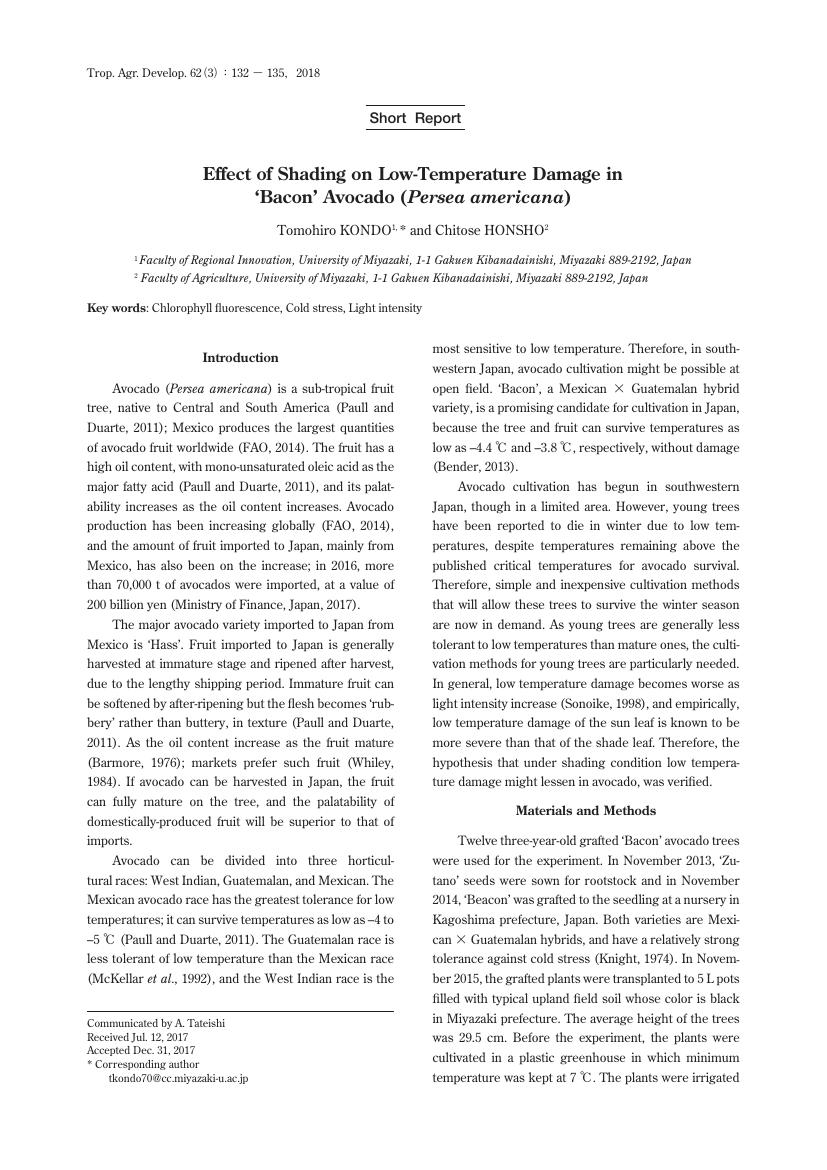2 0 0 0 OA Anatomical Study of Passion Fruit Aril Structure and Juice Quality in Different Aril Parts
- 著者
- Tomohiro Kondo Hirokazu Higuchi
- 出版者
- The Japanese Society for Horticultural Science
- 雑誌
- The Horticulture Journal (ISSN:21890102)
- 巻号頁・発行日
- pp.QH-093, (Released:2023-10-11)
Passion fruit has edible arils with a complicated structure. Each aril has three different membranes; an external membrane, an internal membrane with a fimbriate structure at the basal area, and a transparent membrane that completely envelops the seed. It was reported that juice quality, including organic acid and sugar contents, varied depending on the extraction method. So, organic acid and sugar are potentially localized inside the aril. In this study, using three cultivars (purple passion fruit, yellow passion fruit, and ‘Summer Queen’, a hybrid variety between the two), juice qualities of different aril parts were determined. The aril was separated into three parts, that is, the outer pulp (OP), the distal part of the inner pulp (DIP), and the basal part of the inner pulp (BIP). The OP included the external membrane and the juice held by this membrane. The DIP surrounding the seed and the BIP was a fimbriate structure attached to the internal membrane. In all varieties, titratable acidity (TA) and citric acid content at DIP were higher than those at OP and BIP, although there were some differences among the varieties. Malic acid content did not vary among the parts. Total soluble solid content (TSS) at BIP was the highest among the parts, and glucose, sucrose, and fructose contents at DIP were lower than those at BIP. Purple passion fruit had a high juice content at OP and the yellow cultivar had high juice content at DIP, while the hybrid between the two showed intermediate characteristics. Organic acid and sugar were localized inside the aril in the passion fruit cultivars; the citric acid content and TA at DIP were higher than those at OP and BIP, and TSS at BIP was higher than those at DIP and OP. Therefore, adjusting the juice extraction intensity may be needed depending on the required juice quality.
- 著者
- Tomohiro Kondo Hana Morizono
- 出版者
- The Japanese Society for Horticultural Science
- 雑誌
- The Horticulture Journal (ISSN:21890102)
- 巻号頁・発行日
- pp.QH-006, (Released:2022-08-20)
- 被引用文献数
- 3
To determine the effects of drought stress, especially light drought stress, on flower number in passion fruit, one-year-old passion fruit plants grown in 7.5 L plastic pots were subjected to different soil water content treatments, namely wetness, light drought, and heavy drought for two months. Average, maximum, and minimum soil water contents (v/v) were 44, 47, and 41% in the wetness treatment, 23, 40, and 11% in the light drought treatment and 11, 33, and 6% in the heavy drought treatment. Flower number decreased as the strength of drought stress increased, although the number of nodes and flower buds did not. Flowering periods were from June 27 to July 19 in the wetness treatment and June 26 to July 16 in the light drought treatment with three peaks around July 1, 6, and 13. In the heavy drought treatment, the flowering period was from July 11 to 18 with one peak. The flower bud number was not affected by drought stress. Light drought stress did not suppress vegetative growth, such as vine length, leaf number, leaf length, or photosynthetic rate, although heavy drought stress did. Stomatal conductance was suppressed by light drought only at 12:00PM and by heavy drought throughout the day. Leaf water potential was decreased by heavy drought at 3:00PM, but not by light drought. In the wetness and light drought treatments, visible wilting was not observed, and in the heavy drought treatment the plants wilted before irrigation, although they recovered about 15 min after irrigation. In conclusion, even light drought stress, which did not suppress vegetative growth, reduced the flower number in passion fruit. Drought stress suppressed flower bud development but not differentiation.
- 著者
- Tomohiro KONDO Chitose HONSHO
- 出版者
- Japanese Society for Tropical Agriculture
- 雑誌
- Tropical Agriculture and Development (ISSN:18828450)
- 巻号頁・発行日
- vol.62, no.3, pp.132-135, 2018 (Released:2018-10-12)
- 参考文献数
- 10
